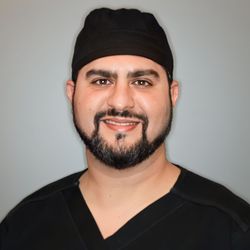When it comes to dentistry, so much has changed over the past few years, decades, and centuries. State-of-the-art dental treatments and archaic protocols of the past have changed the face of oral healthcare.
Dental Implants Hundreds of Years Ago
Replacing missing teeth has always been a problem for humankind. But archaeological research shows us that hundreds of years ago, the Egyptians and Mayans had already come up with ways to implant or wire fake teeth into place. We know that some people would file down bone or seashells to act as replacement teeth. Others in the European dark ages even bought teeth from other people, who had them pulled for money and then they were inserted into the other person’s mouth! And then, there’s George Washington. Somewhere along the line, every elementary student grows up thinking his dentures were made out of wood. The truth is that he had several different sets, but more comfortable tooth replacement treatments weren’t developed until years later.
Fast forward a bit, and the earliest “modern” dental implants involved extensive surgeries where a basic framework was physically set across the mandible. The process was lengthy, painful, and complex. Only few people could afford it, but the invasive nature of the process still made it one that wasn’t always beneficial.
Then what seemed like a sudden turn of events, the most advanced form of dental implants was developed. These newer designs were around the same width and length as natural teeth, truly mimicking the function of an artificial tooth root. This tremendous change allowed modern dental implant therapy to evolve into the “gold standard” of missing tooth replacement. In time, same day dental implants such as TeethXpress and full mouth “All on Four” treatment became so accessible that almost anyone can find a dental implant provider in their area.
Toothbrush Technology
Have you ever wondered how much toothbrushes have changed over the years? Some of the earliest toothbrushes that we know about were made out of sticks with splayed ends. And as time went by, the traditional style of toothbrush we’re familiar with started gaining popularity. But instead of plastic, rounded-end bristles, hog hair was the norm. And you probably wouldn’t have one for each member of your household; you would likely all share the same toothbrush.
Today, we have dozens of sonic and rotary toothbrushes to choose from at a drugstore on every corner. The research shows that the thousands of extra brush strokes that they make can lower your risks of gum inflammation, remove more bacteria, and cut down on tooth stain.
Drill Free Fillings
Thanks to laser technology, dentists can provide minimally invasive procedures that don’t call for usual “drill and fill” techniques. Of course, there are a lot of criteria to meet and not every situation qualifies.
A typical drill free filling uses hard tissue laser technology to gently remove the surface layer of tooth decay and prep the underlying enamel. Laser fillings are specifically reserved for extremely small cavities that haven’t ruptured deep into tooth structure. Since they’re so shallow, numbing may not be necessary either.
Another type of drill free filling is also available. Instead of using lasers, an air-abrasion process sort of “blasts” the cavity away like a pressure washer (that’s a blunt way to put it, but probably one of the easiest comparisons to make.)
In either scenario, drill free fillings are restricted to small cavities because the technology isn’t quite there to efficiently treat larger areas. On the upside, smaller fillings are less invasive to teeth. As long as cavities are diagnosed early and intercepted soon after the exam, a drill free filling could be an option.
Needle Free Numbing
It’s no secret that most of us are afraid of needles. But if you’ve ever had to have major dental work done, a small injection is usually the best way to ensure complete comfort. However, some researchers have been studying how electronic pulses can possibly be used instead of anesthetic to numb areas of the mouth prior to dental work. It’s not perfected yet, but there’s plenty of potential.
Other approaches have included developments like “The Wand”, which is a single-tooth anesthesia delivery system that’s completely computerized. The digital output is delivered through a tiny pinprick, for optimal patient comfort. And since it only affects one tooth at a time, you won’t have to worry about having large portions of your mouth feeling funny for several hours afterward.
“nSequence”
Today, a lot of dental implant specialists use CBCT or “cat scan” imaging in their office. These machines make it possible to get a three dimensional X-ray and scan of your entire oral anatomy; including your airway, nasal sinuses, TMJ, and others. Most use this tool to digitally map out and place the implants, but nSequence adds a new twist to this proven scanning device. During your CBCT scan while you’re having your 3D X-ray of both jaws, the machine simultaneously records a “bite registration”. That is, there’s a digital photographic scan of how your upper and lower teeth bite against one another. In the “old days”, the only way to get a bite registration was to take physical impressions of your teeth.
When you’re able to use a digital bite registration, the computer can marry those biting relationships together. At that point, a dentist or your implant lab can virtually remove any existing teeth and digitally map out implants that fit your anatomy like pieces of a puzzle. It’s an extremely accurate process! The nSequence provides framework for your bone as well, so that we know exactly where to place each implant root.
But that isn’t all. As an end result, we can create guides that are within 1/10mm accuracy to line your implants up on the installation day. That way everything can be pre-made and installed more efficiently. It’s extremely accurate and cuts down on surgery time.
Digitally Guided Dental Tools
One of the newest developments in digital dentistry is 4D guided instruments. With this conceptual technology, any time you’re getting a dental implant installed, your dentist will use an electronic handpiece for adjusting the installation site. Now that CBCT technology is readily available, this type of digital advancement is just around the corner, because dentists can use an existing 3D scan of your oral anatomy and potentially have the opportunity to link it to a special computer system. There, your mouth gets four specific markers. In turn, the computer talks to the handpiece and then knows exactly where the tip of the surgical tool is in relation to your mouth.
In 3D real time, the handpiece talks to the computer software and shows on the screen exactly where the instrument is placed inside of a tooth or bone structure. Essentially it gives your implant dentist an inside look even when other anatomy is blocking their current line of sight. It’s like virtual reality meets robotic surgery inside of the dentist’s office and it will be here sooner that you realize!
Lower Radiation Levels
X-rays were first discovered back in 1895. But back then there wasn’t a lot that they knew about radiation exposure. In fact, one of the first X-rays is of a woman’s hand (you can see her ring on the image) where she sat there for an extended period of time — likely around 10 hours — being exposed to unfiltered radiation. Sadly, she died an extremely gruesome death because of it (her name was Anna Bertha Roentgen if you want to read up on it!)
As scientists began to better understand radiation, they learned that it was necessary to monitor exposure levels and even how it was delivered (such as through a smaller lead tube head) to prevent exposure in other parts of the body.
Fortunately, we’ve come an even longer way in regard to X-ray safety. Today’s digital dental X-rays use as much as 90% less radiation as the safe radiographs that we took in the 1990s and early 2000s. Still, we practice limited exposure protocols where lead aprons cover all reproductive organs (including the thyroid gland) and practitioners step behind a wall to prevent cumulative exposure. But the levels are so low that getting a few dental x-rays is actually “safer” than the radiation you’re exposed to on a day out at the beach or cross-country flight.
Platelet Rich Plasma (PRP) Treatments
Platelet rich plasma — or “PRP” for short — is a process where your dental provider can tap into your body’s own repair process to speed up healing following oral surgery procedures.
With a PRP treatment, a small amount of blood is collected in a vial, the same way any typical lab work is done. Then the vial goes into a special spinning machine that separates the different cellular makeup of your blood. The PRP is then put back into the surgical site and accelerates the healing process.
Some of the most common scenarios to use PRP treatments are for oral surgeries like sinus lifts, ridge (bone) augmentation, and following tooth or wisdom teeth extractions.
We can also combine PRP with clotting agents to modify bone graft material that’s easier to mold into specific areas.
An offshoot of PRP treatments is “L-PRF” or leucocyte platelet rich fibrin. This slightly different adaptation helps create a protective membrane to cover grafts and speeds up fibroblast formation (which your body needs to heal any type of an open wound.)
L-PRF also cuts down on swelling, which is one of the most common causes of post-operative discomfort.
Digitally Designed Dental Crowns
Crowns, or “caps” as a lot of people call them, are full coverage restorations that cover your entire tooth. They’re used if you have a large cavity, recently got a root canal, or to top off a dental implant when you’re replacing a single missing tooth.
In the past, getting a dental crown involved a two-step process that lasted at least a couple of weeks. It involved prepping your tooth, taking an impression, sending the model off to a lab, and then waiting for the crown to get made and shipped back. If for some reason it didn’t fit, the process had to be repeated.
But CAD/CAM technology started to change the crown fabrication process. Just like you see digital printing popping up in schools all over the country, dentists are using the same technology to mill custom dental crowns out of solid blocks of porcelain.
Not only do CAD/CAM dental crowns save time by making the restoration in just one appointment, they also eliminate the risk of human error. So, there’s never a big risk of having to repeat the process or come back for another visit in two weeks. Plus, every custom milled crown is carved out of a ceramic shade selected to match your other teeth.
Long Lasting, Narcotic Free Pain Relievers
Over the past several years there have been big pushes to slow down how many narcotics and opioids are prescribed. Some have said that one of the first exposures a person ever gets to prescription narcotics is after an oral surgery like wisdom tooth removal. As such, dentists have been at the forefront of pain relief research to find ways to provide safer and gentler care to their patients.
One development has been the incorporation of a drug known as Exparel. This extended-release medication has been used for years in procedures such as C-sections. It’s unique in that it has a long acting ability to desensitize and block pain transmission without any type of narcotics.
Dental Magnification
Surgeons aren’t the only medical specialists to use tiny cameras inside of your body during procedures. Dentists can now turn to technology such as the Perioscope, which is a small camera that contains 14,000 optic threads within a 1mm fiber.
When the Perioscope camera is slid into areas throughout your mouth, it provides up to a 50x magnification in high resolution on an adjacent screen. It’s specifically used for periodontal procedures like deep cleanings, to ensure that all residual bacteria and buildup have been cleaned off of the teeth.
Powered Cleaning Instruments
“In the old days” getting your teeth cleaned and polished involved a tedious process where a manual polisher had to be rubbed meticulously across each and every tooth. Needless to say, it took a lot of time, but it was also difficult on the people performing hygiene duties.
Fortunately, we have a variety of different tooth polishing mechanisms that quickly remove surface stains and prevent repetitive injuries. You’re probably most familiar with the rubber cup polisher, which is a small device that spins against the tooth. Air polishing is also effective, but a bit messier.
Additionally, ultrasonic instruments are more effective and efficient for overall dental cleanings. There are even special tips that have been designed for safe use on dental implants.
Surgery Free Gum Recession Options
If you have exposed tooth roots because of gum recession or aggressive tooth brushing, you might be able to bypass gum grafting. Recent studies have shown that depending on the tooth, the gum tissues next to it can be gently lifted and stretched over the exposed area to re-cover the root surface. It’s called “Pinhole” rejuvenation because of the tiny pinprick opening that’s created in the gums.
Invisible, Removable Braces
Cosmetic dentistry and orthodontics married up in the early 2000s when Invisalign overtook the braces industry. Also based on 3D CAD/CAM technology, Invisalign and other clear braces providers use digital mapping to pre-plan tooth movement without brackets and wires. Instead, a series of removable aligners are worn and changed out every two weeks. With each set, your teeth are guided into the ideal position.
Clear braces used to be more expensive and restricted to milder cases. But today they’re relatively competitive in cost and useful for more moderate to severe tooth misalignment cases. And if you needed another reason to think about getting Invisalign, having straighter teeth can statistically lower your chances of getting tooth decay and gum disease.
Soft Tissue Laser Treatments
Gum recontouring can be both a cosmetic and therapeutic service. It involves improving the appearance of gum tissues by removing excess gingiva (gums) to reveal more tooth structure. In the past, the only way to adjust gumlines was by using more invasive surgical measures. But now soft tissue lasers are changing that.
Laser gum disease therapy and procedures like Twinlight or “LANAP” use dental lasers to safely remove diseased gum tissues, treat deep pockets, and aid in tissue reattachment to the tooth root. It’s a great adjunctive procedure for some people with periodontal disease.
Are you prone to cold sores popping up regularly? Soft tissue lasers can shorten the lifespan of a typical fever blister by up to 50%. The key is to find a laser dentist quickly and get your cold sore treated as soon as you start noticing symptoms. Even if you don’t see a visible ulcer but you can tell the tingling or burning sensation is starting, that’s the best time to call.
A Stronger Correlation with Sleep Medicine
The more we learn about sleep disordered breathing conditions like sleep apnea, the more we see how they’re linked back to dental issues. For instance, the shape and size of your lower jaw and soft tissues in the back of your mouth may play a direct role in obstructive sleep apnea (OSA).
To help treat the problem, sleep dentistry experts have developed therapies like oral sleep appliances and laser snoring treatments. In the first, your mouth is positioned with a specially made mouthguard to naturally open your upper airway while you sleep. In the later, a laser is used to gently treat the soft tissues near the back of your mouth that are responsible for snoring and blocking off air. Both are effective, but you can’t get them from a typical sleep physician; you’ll have to see a dentist who has that technology on hand.
Concussion Prevention
Sports injuries are one of the primary causes of concussions and other traumatic brain injuries. Recent research has shown that specially made dental mouth guards (or “sports guards”) can prevent the mandible/lower jaw from exerting force to the base of the skull and brain. That way even if blunt force injury occurs because of a hit or fall, there’s less of a chance for certain types of concussions to occur.
Plus, they significantly lower your chances of a dental emergency like a chipped or knocked out tooth.
Earlier Screening for Oral Cancer
We used to assume that oral cancer was only linked to tobacco use or alcohol consumption. While those factors do raise your risk of oral cancer, today we know that you can also develop the disease because of sun exposure or viruses like HPV (the same viral strain that causes cervical cancer.)
Although visual oral cancer screenings are standard in most dental facilities, more advanced technology is available for earlier detection of precancerous tissues. One example is a system that uses special lights to illuminate pathological or irregular cells, long before they’re visible to the naked eye. That way your dentist can biopsy them for earlier study and treatment.
Regrowing Teeth Using Stem Cells
Dental scientists are still using stem cell research to try to figure out how to re-grow teeth using our own genetic programming. We can already grow skin for burn victims. Teeth, hair, skin, and fingernails are all similar types of tissues. So, if we one day figure out how to grow new teeth from the right stem cells, it could potentially eliminate the need for dental implant treatment altogether!
Staying Abreast of the Best Treatments
Technology and research are an ever-developing state in modern dentistry. What’s available in some areas may not be in others. Or certain treatments have to be determined on a case-by-case basis, depending on the person’s health, oral anatomy, and the expertise of their dental provider.
Leading Conroe, Spring, The Woodlands periodontist is one of the most experienced implantology specialist in The Woodlands and North Houston. By incorporating proven technology and combining it with his 30+ years of experience in patient care, we can provide the highest quality services to each and every patient. One of our doctors at PCE is part of ongoing professional development groups who are committed to staying abreast of the latest developments and scientific research, including the Greater Houston Society of Periodontics, Pankey Institute Dental Study Group, Texas Society of Periodontics, Brazos Valley District Dental Society, and American Dental Association. Call us today for an appointment!
Office Hours
MON - THU8:00 am - 5:00 pm
FRI8:00 am - 2:00 pm
SAT - SUNClosed
Office Hours
MON - THU8:00 am - 5:00 pm
FRI8:00 am - 2:00 pm
SAT - SUNClosed














